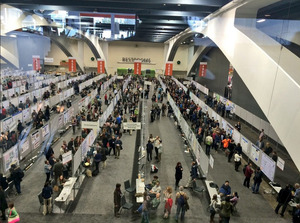ELSI Blog
81 Back from AGU feeling more "ELSI"
About 24,000 attendees gathered at the American Geophysical Union (AGU) Fall Meeting in San Francisco from all over the world this last 15-19 December 2014 to present publicly their fresh scientific results.
Also this year, the city in all its beauty offered the opportunity to build up new collaborations between scientists or share their excitement for the work in progress among collaborators, maybe even drinking a glass of tasty Californian wine or two.


For someone like me who comes from the Mediterranean area, flying to San Francisco (California in general) is really like flying back home due to the special warm atmosphere. One gets the chance to eat good food, chat with many friends after one year of not seeing each other, and take the unique opportunity to watch the strongest NBA team of the season with your office-mates (this really happened this year!) Once again, almost like a tradition, I had the chance to fly to San Francisco and I enjoyed this week, but definitely much more than the previous years.
In fact, if usually the AGU starts unofficially at the Customs and Immigration Office of SFO airport (the kilometer-long line is ~99.9% made of AGU attendees), this year I took my flight from Matsuyama (where I currently live with my wife and two kids) to Osaka, and there I already met a few colleagues easily identifiable from their long poster tubes. Now I am working at the Geodynamics Research Center (Ehime University) as a member of ELSI as of only a few months ago. So, the idea to meet other colleagues from Tokyo for the first time at AGU made me particularly excited during my flight...when, suddenly, I realized that the lady sitting beside me was Hanako Ricciardi, the coordinator of international initiatives at ELSI. What a nice coincidence and what better way to introduce myself!
Now, if you have experienced AGU you must know that meeting someone can be really hard as oral/poster sessions of interest overlap very often, rivers of researches walk from Moscone South to Moscone West back and forth, and meeting points (possibly the one you chose) become crazily crowded. Unless...ELSI had its own booth. 
Easy to find, the ELSI booth was the perfect reference point to meet people, have highly scientific discussions, think of collaborative projects, plan workshops and take a rest sipping a blonde beer or sake which they served in the afternoon.
Among various interesting topics spanning the fields of astrobiology, planetary formation, geomorphology, hydrology, geology, Earth's interior, this year AGU hosted many talks of interest for ELSI members. Particular attention was paid to the session dedicated to the international Rosetta mission during which the long awaited preliminary collected data were shown and, amazingly, described what seems to be an outgassing comet a bit "stinky" because of the predominant sulfur-rich compounds, but also quite enjoyable owing to the large amount of alcohol...-like polymerized molecules from it subsurface, as many of you might have heard from the given talks.
As anticipated, this year there were many interesting sessions that marked our current knowledge on the origin of planets starting from a Solar Nebula, their evolution and, ultimately, how they become potentially habitable. And, likely, the Rosetta mission is going to reveal the ingredients to build a terrestrial-like planet.
On the other hand, we keep interested in understanding how our Earth has changed in the last 4.5 billion years, how the volatile budget has been affected by magmatic processes occurred in the interior of the planet. One question might be regarding the possibility to link the first stages of the Earth formation to the air we breathe today?
Well, an attempt to answer this question came from a fascinating session entitled "Carbon: Storage, Migration, and Outgassing within Earth and Other Planetary Bodies" that I had the pleasure to chair with colleagues from the US, UK and Germany, and the idea of which was raised during an unforgettable workshop in Costa Rica last February.


This session, that was included in the SWIRL theme "Volatile Cycles: Linking Earth's Interior and its Atmosphere" and received support from the Deep Carbon Observatory, represented a unique opportunity to focus on the important role of carbon in Earth's mantle processes such as melt segregation, diamond formation and CO2 degassing to the atmosphere by collecting together diverse scientific contributions. For those sitting in the audience this was a great opportunity to get an overview on the behavior of this volatile species and related mechanisms for its speciation from deep in the Earth up to the surface, almost like reading chapters from a book.


Now, if some of you are eager to know what I am working on at GRC, I can tell you this session well reflected my scientific subjects. Or, maybe, I should say that as an ELSI member I am investigating the redox state of the Earth's interior by performing experiments at high pressure and temperature to determine the variation of ferric iron in redox sensitive mantle minerals with all the possible implications for the volatiles cycling and with particular attention for the chemistry and physics of carbon at extreme conditions.
Let me conclude saying that early December was quite cold in Japan and there was no way to not get sick. However, after being back from AGU, I feel more healthy, or maybe I should say...more ELSI!
See you soon in Tokyo at the 3rd ELSI International Symposium!











